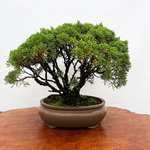gjones_42
Yamadori
I'm hoping to get some detailed input on how to acclimate a new-to-me Shimpaku that I received as a gift. I'm an absolute noob to bonsai (avid plant lover though) and this is a beautiful tree that I really want to see thrive. I've been on the fence about when to get started and wouldn't have picked this as my entry point, but here I am so I'll have to dive right in and learn on the fly!
I've been researching like a madman and it seems the most pressing thing is to get it ready for winter. It did not arrive with any information on whether it was mid-hardening, and I'm waiting on this info from the source. Since it is currently in the sunniest window in my kitchen, I need to make a decision on where it is going ASAP, and this is where I can use some input. I am in MA in zone 5b, but located in a valley so tends to be a bit chillier than elsewhere.
It seems like I should get this outside now so it can start hardening for the winter, but I am worried about the roots freezing given that the temps are dipping to 29-32F at night, and I see frost on some surfaces. To complicate things a bit more, the safest location for my plants (i.e., away from the ravening horde of deer) is on a 1st story deck that is south facing. Tons of sun during the day, but open exposure to wind from 2 directions. I know this is not a safe location for all of winter based on losing other potted plants to frozen roots. I overwinter my other plants (young fruit and evergreen trees) in an unheated garage with a single window, and they've fared well.
Is it too soon to stick my Shimpaku in the garage? I didn't want to put it out during the day and bring it in at night since the warmth would impact the hardening. Would it suffice to wrap the roots in some blankets or build a small box from styrofoam to acclimate it for the next few weeks? I've seen posts in the forum about using leaves or mulch to protect the roots, but not sure how to do this on the deck.
I appreciate any good input on where to go from here! I suppose the good news is I'll have plenty of reading to do this winter so I am ready for spring
I've been researching like a madman and it seems the most pressing thing is to get it ready for winter. It did not arrive with any information on whether it was mid-hardening, and I'm waiting on this info from the source. Since it is currently in the sunniest window in my kitchen, I need to make a decision on where it is going ASAP, and this is where I can use some input. I am in MA in zone 5b, but located in a valley so tends to be a bit chillier than elsewhere.
It seems like I should get this outside now so it can start hardening for the winter, but I am worried about the roots freezing given that the temps are dipping to 29-32F at night, and I see frost on some surfaces. To complicate things a bit more, the safest location for my plants (i.e., away from the ravening horde of deer) is on a 1st story deck that is south facing. Tons of sun during the day, but open exposure to wind from 2 directions. I know this is not a safe location for all of winter based on losing other potted plants to frozen roots. I overwinter my other plants (young fruit and evergreen trees) in an unheated garage with a single window, and they've fared well.
Is it too soon to stick my Shimpaku in the garage? I didn't want to put it out during the day and bring it in at night since the warmth would impact the hardening. Would it suffice to wrap the roots in some blankets or build a small box from styrofoam to acclimate it for the next few weeks? I've seen posts in the forum about using leaves or mulch to protect the roots, but not sure how to do this on the deck.
I appreciate any good input on where to go from here! I suppose the good news is I'll have plenty of reading to do this winter so I am ready for spring






